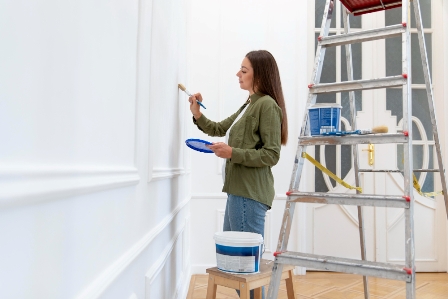In recent times, the do-it-yourself (DIY) culture has gained immense popularity, especially in the realm of home renovation. More homeowners are taking on the challenge of transforming their living spaces independently, seeking the satisfaction of creating something with their own hands. This article explores the intricacies of DIY renovation, offering a comprehensive guide to mastering the art like a pro.
Getting Started with DIY Renovation
Embarking on a DIY renovation journey requires a realistic assessment of one’s skills and capabilities. Before diving into a major project, it’s crucial to set achievable goals and understand the commitment involved. This initial step sets the tone for a successful renovation experience.
Essential Tools and Materials
A well-equipped toolkit is the cornerstone of any successful DIY project. From hammers and saws to more specialized tools, assembling the right set is vital. Additionally, choosing quality materials ensures the longevity and durability of the finished product.
Planning Your Renovation Project
The key to a seamless DIY renovation lies in meticulous planning. Developing a detailed project plan, including a budget, helps in avoiding unexpected challenges and ensures a smoother process from start to finish.
Safety First: Precautions and Guidelines
Safety should always be a top priority in any DIY project. From wearing the appropriate protective gear to understanding basic safety guidelines, taking precautions is non-negotiable.
Mastering Basic Carpentry Skills
Carpentry is often a fundamental aspect of many home renovations. This section provides an overview of essential carpentry techniques, offering a step-by-step guide for beginners to build confidence in their skills.
Tackling Electrical and Plumbing Challenges
Even for beginners, understanding basic electrical work and plumbing fixes is essential. The article breaks down these seemingly complex tasks into manageable steps, empowering DIY enthusiasts to handle them with confidence.
Choosing the Right Paint and Color Schemes
Choosing the right paint and color schemes is a pivotal step in any renovation project. The colors you select can set the tone for a room, influence mood, and contribute to the overall aesthetic of your living space. Let’s dive into the world of colors and paints to help you make informed and inspired choices for your DIY renovation.
Understanding Paint Finishes
Before exploring color options, it’s crucial to understand different paint finishes. Matte, eggshell, satin, semi-gloss, and high-gloss are common finishes, each with its unique characteristics. Matte finishes offer a flat, non-reflective surface, while high-gloss reflects light for a shiny appearance. Consider the function of the space when choosing the finish; kitchens and bathrooms may benefit from more durable, semi-gloss or high-gloss finishes.
Exploring Color Psychology
Colors have psychological effects, influencing emotions and perceptions. Warm colors like reds and yellows can evoke energy and warmth, making them suitable for social spaces. Cool colors such as blues and greens create a calming atmosphere, ideal for bedrooms or relaxation areas. Understanding color psychology can help you choose hues that align with the purpose of each room.
Harmonizing Color Schemes
Creating a harmonious color scheme involves selecting colors that complement each other. The color wheel is a valuable tool in this process. Monochromatic schemes use variations in lightness and saturation of a single color, while complementary schemes combine colors from opposite sides of the wheel. Analogous schemes involve colors adjacent to each other, offering a cohesive look. Experiment with different combinations to find the harmony that resonates with your vision.
Flooring Options and Installation Techniques
Flooring is a transformative element in any renovation. Readers will discover popular flooring materials and receive DIY-friendly installation tips for a professional-looking finish.
Revamping Spaces: Room-Specific Renovation Tips
Specific areas like kitchens and bathrooms often pose unique challenges. This part of the article delves into tailored renovation tips for these spaces, making the process more approachable for DIY enthusiasts.
Upcycling and Repurposing Furniture
For a truly personalized touch, upcycling and repurposing old furniture can add character to a renovated space. This section offers creative ideas and projects to breathe new life into existing pieces.
Landscaping on a Budget
Renovation isn’t limited to the interior of a home. DIY enthusiasts can enhance curb appeal with budget-friendly landscaping ideas and gardening tips, creating an inviting exterior space.
Troubleshooting Common DIY Challenges
Mistakes are part of the learning process. This section addresses common challenges in DIY projects and provides guidance on overcoming setbacks gracefully. Knowing when to seek professional help is also emphasized.
Celebrating Success: Showcasing Your DIY Masterpiece
Documenting the renovation journey and sharing achievements with the community is a fulfilling aspect of DIY projects. This section encourages readers to take pride in their accomplishments and inspire others in the process.
FAQs
Yes, with careful planning and the right resources, beginners can successfully undertake DIY renovation projects.
The article provides a detailed guide on budgeting considerations for DIY renovations.
The safety-first section outlines essential precautions and guidelines for DIY enthusiasts.
The article breaks down basic electrical work into manageable steps for beginners.
The “Celebrating Success” section offers tips on documenting and sharing your DIY masterpiece with the community.
Conclusion
Mastering the art of renovation through DIY endeavors is not just about enhancing living spaces; it’s a journey of self-discovery and accomplishment. As you navigate the challenges and triumphs of your DIY projects, remember that the process itself is as valuable as the finished result.






